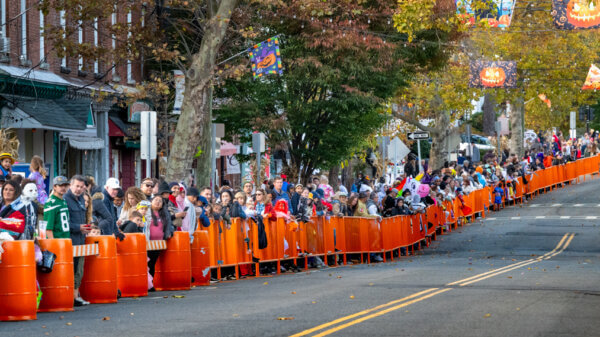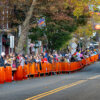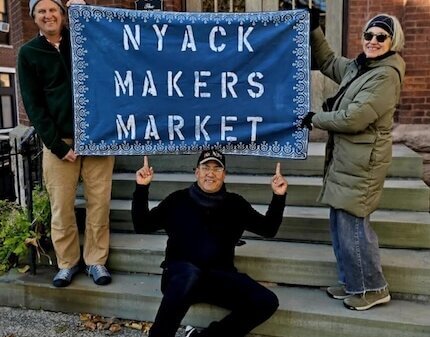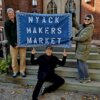Embarking on a journey through Nyack’s rich history, we unveil the riveting tale of the Nyack Rowing Association (N.R.A.), a charismatic crew that once graced the waters of the Tappan Zee. Channeling the spirit of Boys in the Boat, Nyack’s own rowing saga unfolds against the backdrop of a glorious Victorian boathouse, weaving together a tapestry of camaraderie, competition, and grandeur.
Picture it — 1881, Nyack’s upper echelons coming together to form the N.R.A. A roster brimming with notable names like Stephen Bradley and William Voorhis set the stage for an era of rowing opulence. It wasn’t just a club; it was a rendezvous for the crème de la crème of Nyack society, a spectacle rivaling the grandeur of the Gilded Age itself.

Rowing Clubs in America
Rowing became America’s favorite sport in the 19th century powered by the formation of rowing clubs. The Narraganset Boat Club became the first rowing club in 1838. Soon after, Yale and Harvard formed famous clubs that still exist today, starting the oldest formal race, the Harvard-Yale Regatta, in 1852. By 1894, the Poughkeepsie Regatta became the “Super Bowl” of college crew racing in 1895. It became the greatest one-day sporting event in America with tens of thousands of spectators.

Founding of the Nyack Rowing Association
Two close friends, Julian O. Davidson and Arthur Merritt, came up with the idea for the N.R.A. and became the driving force in its formation. The club incorporated in May 1881. The club’s colors and rowing uniform reflected Davidson’s artistic flair. Club rowers donned colorful rowing uniforms of a sleeveless gray shirt with a diagonal red stripe front and back, dark navy-blue trunks, and a cap of gray and red. Later, the club adopted a formal blue suit with gilt buttons and a visored naval cap.
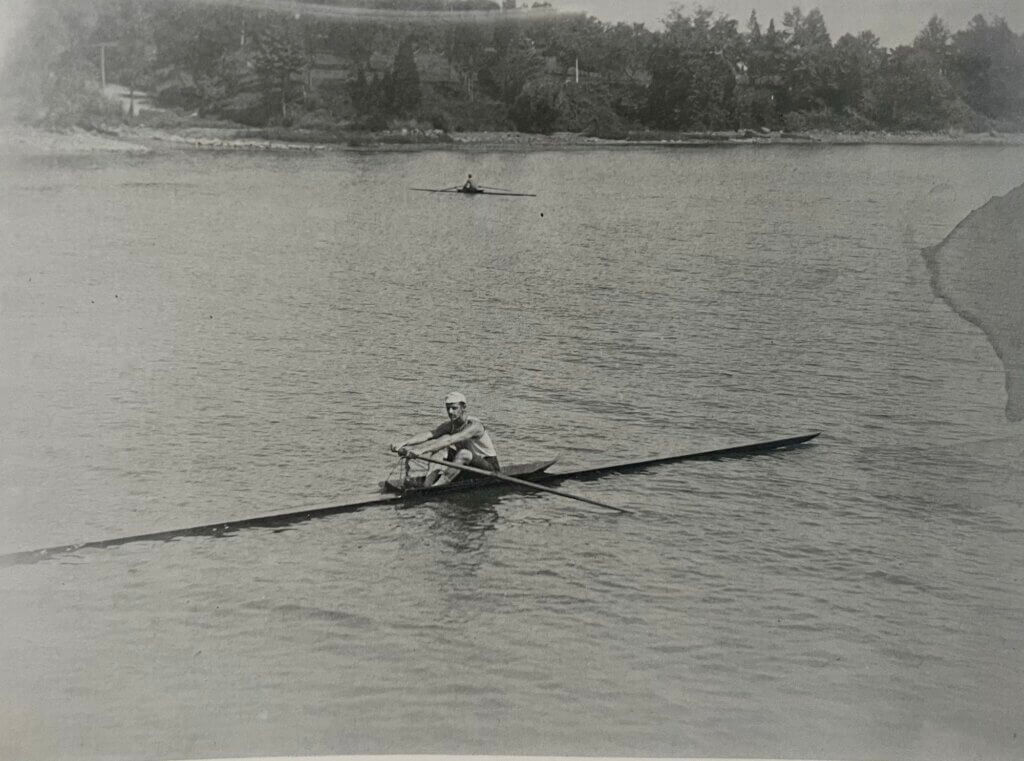
Julian O. Davidson
Davidson, a skilled and well-known marine painter in his day, is worthy of special mention in relation to the N.R.A., for without him the N.R.A. would have not come into existence. Born in 1853 he came to Nyack as a young man after traveling the world, befriended by Arthur Merritt. He married Arthur’s sister Cornelia in 1877. Together they built a lovely house in 1885 at 117 South Broadway in South Nyack. In addition to his prowess as a painter and rower, he organized for the N.R.A. a full calendar of artistic, cultural, and educational events for club members and the public. Through his efforts the clubhouse remained open during the winter. His life and family ended abruptly in tragedy. His child died in childbirth, Davidson died of Bright’s disease at age 40, and his wife died soon after.

A Magnificent Boathouse
Picture the magnificent sight of a majestic four-story Victorian marvel complete with cupola, tower, and flying pennants, standing regally at the foot of Spear Street. W. H. Smith, a local architect designed the structure that jutted out from the shore on the old People’s Dock. The building’s striking presence became the first recognizable building in Nyack sighted by boaters as they entered the Tappan Zee from New York City.

A gangplank on the river provided access to storage space for sculls, barges, and equipment on the first floor. The second floor contained the main salon or ballroom with fireplaces at either end. A large gas chandelier hanging in the center lit the room. Davidson created canvas paintings to decorate the walls and decorated the glass transoms with marine paintings above doors leading to the club office and a “women’s boudoir” on the west end. French doors on the river side opened to a veranda that ran around three sides of the building affording excellent views of the river.
The First Regatta
Almost the entire village turned out for the first club regatta on a July 4th weekend in 1882. Members and guests crowded the boathouse porches. Others lined the local docks to catch a view of four different races. The junior sculls started at 10a followed by the senior sculls, 4-oared sculls, and a fun-filled “tub race”. Davidson’s crew defeated the Voorhis team thanks to high waves that swamped the Voorhis boat. In the evening, the club held a buffet dinner for members and guests and then a ‘hop” or dance in the ballroom. Following the dance, a large fireworks display bedazzled the entire village. The regatta became an annual event much anticipated by villagers.
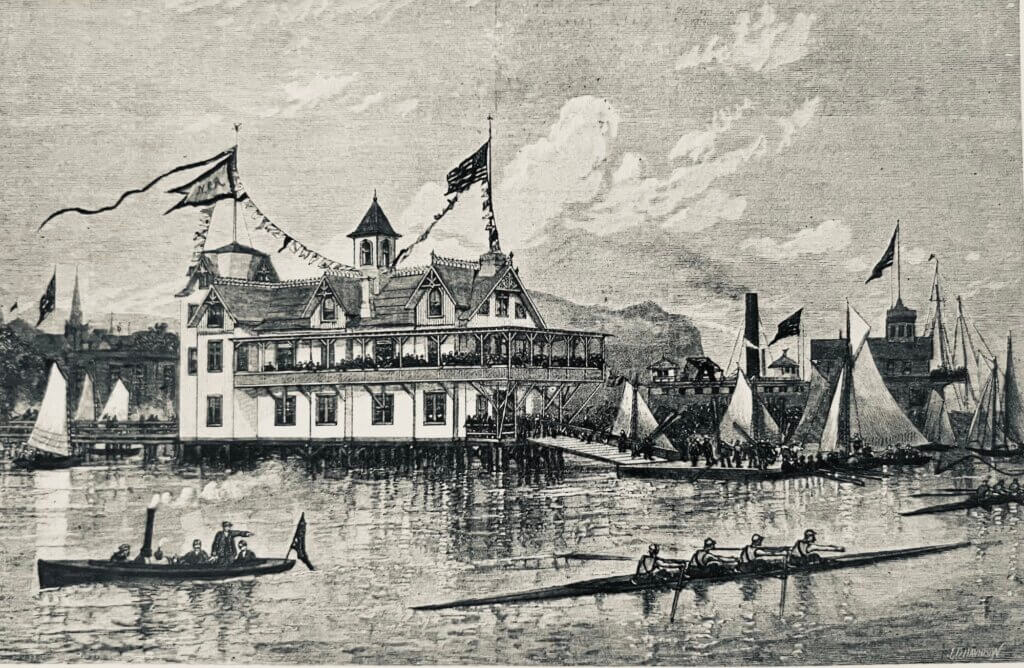
Social Events Fuel Growth
The club became more than an athletic club for men. A busy social calendar included women and in many cases non-member friends. Social events of every sort became regular events for the club with up to 150 people in attendance. The ballroom was sumptuously decorated with art, flowers, potted plants, and colored lights. Members enjoyed dinners, usually catered by Mrs. Fraser, owner of Fraser’s Ice Cream Parlor, before dancing and live music. Games of euchre filled many nights.
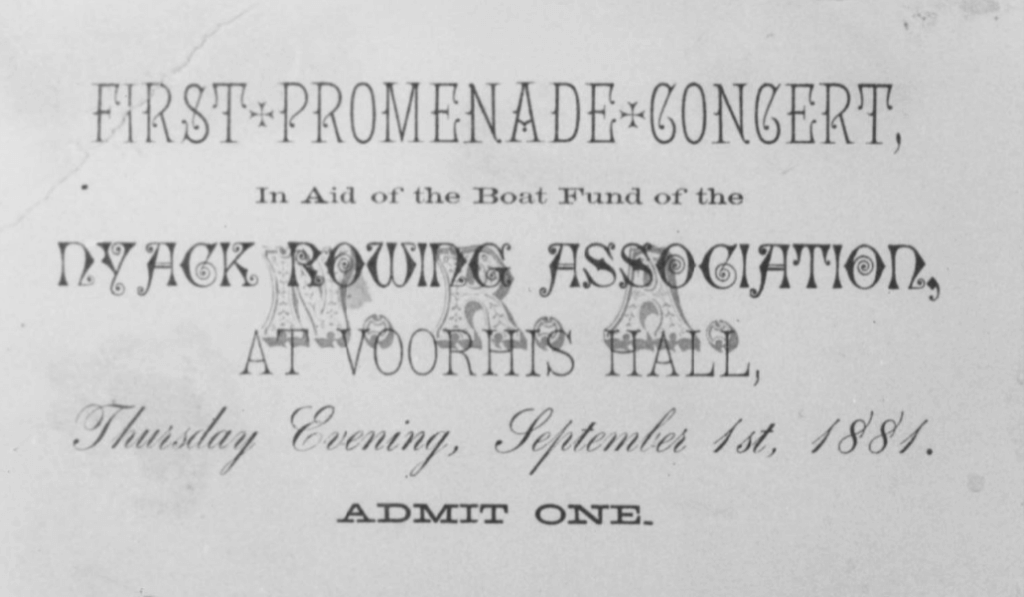
Davidson developed a series of social events at Voorhis Hall during the winter season. Concerts, a magic show, minstrel shows, a comic opera, and lectures proved popular. In 1883 Henry Ward Beecher, an abolitionist and early Darwinian, gave a lecture to a standing room only crowd. Beecher, an early abolitionist, took up Darwinism in the 1880s.
Billiards, Bowling, & Baseball
The club wasn’t limited to rowing events. Club members started a baseball team and played billiards on the top floor of their clubhouse with its fine views of the Tappan Zee. The club took on all comers for intense matches at its two-lane bowling alley, one of the first in Nyack. Teams from the YMCA and the Piermont Rowing Club regularly bowled against members of the club. The club held swimming races in lengths from 100 yards to one mile with swimmers coming from as far as Canada and New York City to compete. Sailing races of around six miles began and ended at the clubhouse.

Boy’s Night Out
Club members and guests held any number of events in the clubhouse. During one typical evening, the club hosted a six-round boxing match, a piano performance by Joseph Sturtevant accompanied by two banjo players. A quartette, including the father of Joseph Cornell, a famous 20th century artist, sang. Refreshments and plenty of cigars enlivened the evening.
Women at the Club
Women could not become members. Tuesdays became “Ladies Day” when female guests of members held sway at the club after 10a. Of course, women worked tirelessly in helping at fund raisers and during events to which they were invited.
Moonlit Barge Rides
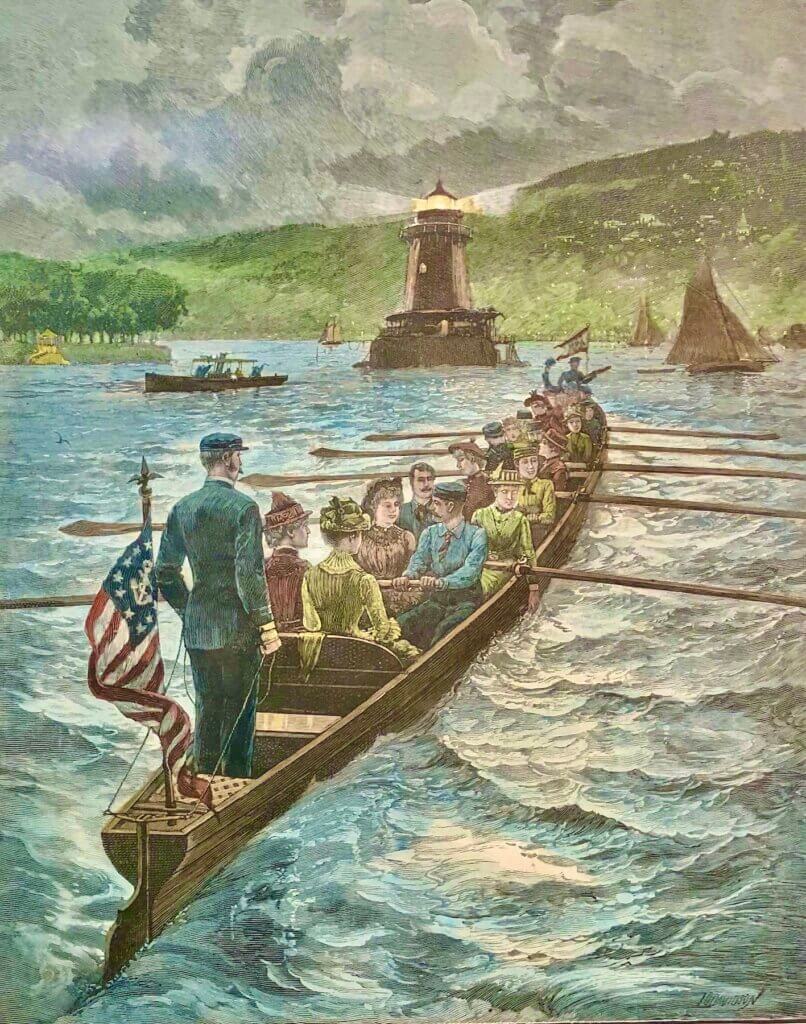
The club acquired an 10-oared boat that seated 24. The barge became popular for hosting female guests on the Tappan Zee in the evening. One event, illustrated by Davidson, depicted a trip across the Tappan Zee to Tarrytown Light on a moonlit night. Club members dressed in full club regalia.
Club members were known to take other nighttime trips using the barge including trips to Hook Mountain, Judge Leo Dresser’s elegant South Nyack mansion for dinner, and a trip to the Palisades Rowing Club in Yonkers that began in the afternoon, followed by a party, ending back at the boathouse at 12:30a.
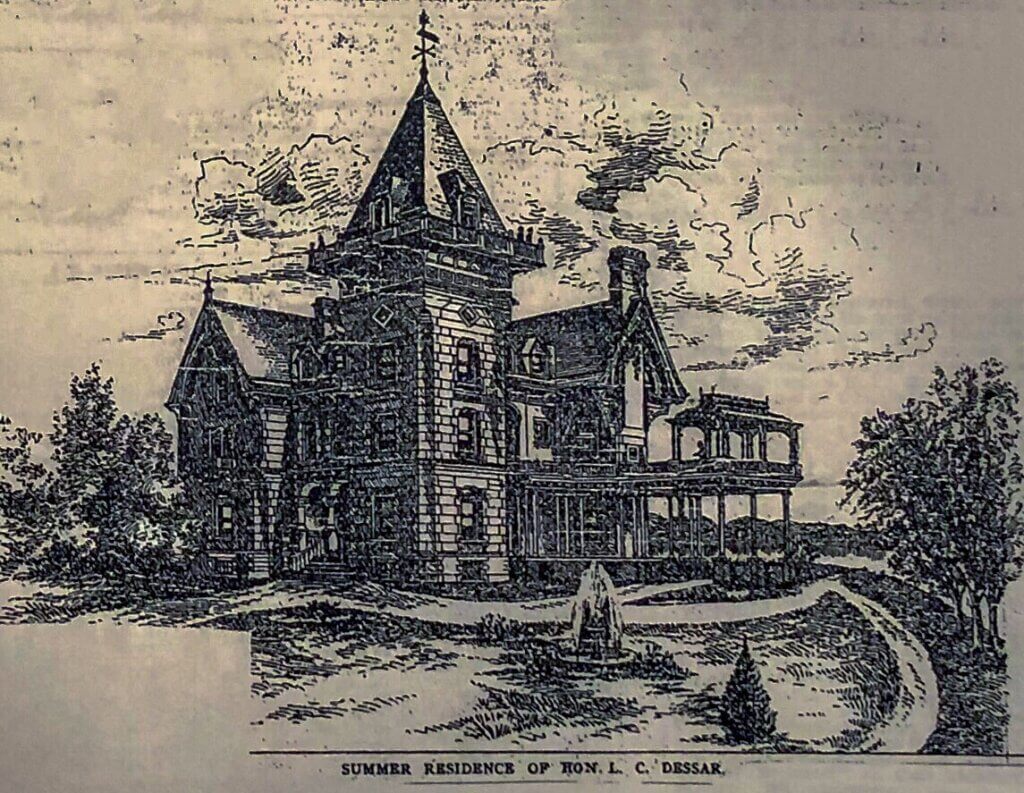
Decline of the Club
As Davidson’s health declined, the club lost much of its energy. Even the election of Clarence Lexow, Nyack’s most famous citizen at the time, as President couldn’t bring the club back to the halcyon days of the 1880s. In 1901, the club disbanded, roughly coinciding with the creation of the Nyack Boat Club in 1909.
The Club’s Legacy
The old clubhouse, situated as it was near the Nyack docks, became a boatyard for many years. Damaged once by a hurricane in 1937, a second storm during Thanksgiving weekend in 1950 destroyed the boathouse and docks. Boards from the boathouse lined the shores of Memorial Park for days afterwards.
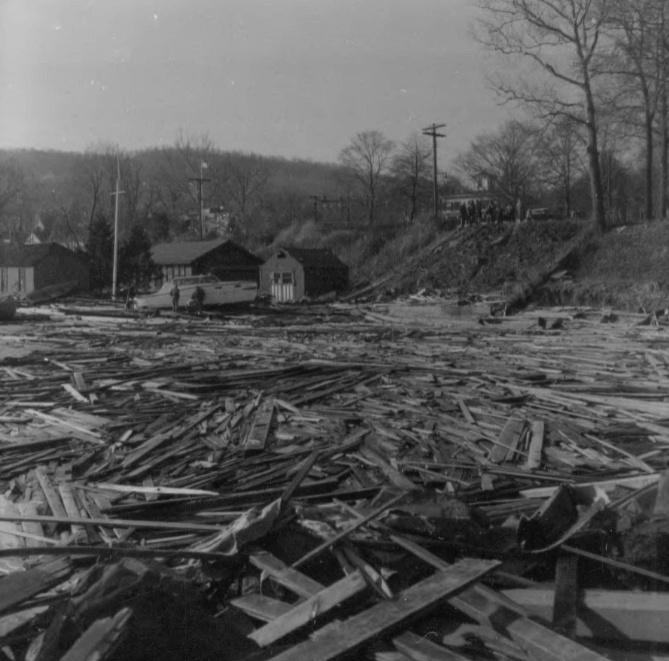
The demise of the N.R.A. marked the end of an era when the club provided a social bond for the village. The young men, Nyack’s own Boys in the Boat, succeeded beyond their dreams in creating a distinctive and memorable social and athletic community within Nyack and Rockland County. While the N.R.A. existed for only a brief period during the Gilded Age, it spawned lasting romantic memories of laughter and joy on the Tappan Zee.
For more on the Nyack Rowing Association see:
Julian O. Davidson and the Nyack Rowing Association, Lynn S. Beman, South of the Mountains, Historical Society of Rockland County, Vol. 30, No. 4, 1986
Julian O. Davidson: Painter of Ships and Boats, Gini Stolldorf, Newsletter, Historical Society of the Nyacks, Volume 6, issue 3, 2011.
Mike Hays is a 38-year resident of the Nyacks. He worked for McGraw-Hill Education in New York City for many years. Hays serves as President of the Historical Society of the Nyacks, and Vice-President of the Edward Hopper House Museum & Study Center. Married to Bernie Richey, he enjoys cycling and winters in Florida. You can follow him on Instagram as UpperNyackMike.
Editor’s note: This article is sponsored by Sun River Health and Ellis Sotheby’s International Realty. Sun River Health is a network of 43 Federally Qualified Health Centers (FQHCs) providing primary, dental, pediatric, OB-GYN, and behavioral health care to over 245,000 patients annually. Ellis Sotheby’s International Realty is the lower Hudson Valley’s Leader in Luxury. Located in the charming Hudson River village of Nyack, approximately 22 miles from New York City. Our agents are passionate about listing and selling extraordinary properties in the Lower Hudson Valley, including Rockland and Orange Counties, New York.




